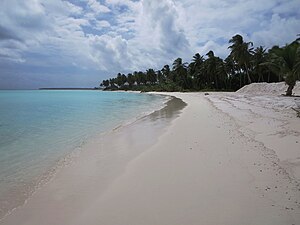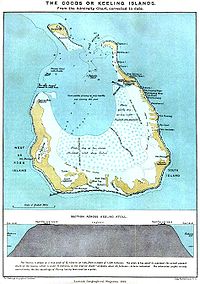
A | B | C | D | E | F | G | H | CH | I | J | K | L | M | N | O | P | Q | R | S | T | U | V | W | X | Y | Z | 0 | 1 | 2 | 3 | 4 | 5 | 6 | 7 | 8 | 9
Cocos (Keeling) Islands | |
|---|---|
| Territory of Cocos (Keeling) Islands Pulu Kokos (Keeling) (Cocos Islands Malay) Wilayah Kepulauan Cocos (Keeling) (Malay) | |
| Motto: | |
| Anthem: "Advance Australia Fair" | |
 Location of the Cocos (Keeling) Islands (circled in red) | |
| Sovereign state | |
| Annexed by the United Kingdom | 1857 |
| Transferred from Singapore to Australia | 23 November 1955 |
| Capital | West Island 12°11′13″S 96°49′42″E / 12.18694°S 96.82833°E |
| Largest village | Bantam (Home Island) |
| Official languages | None |
| Spoken languages | |
| Government | Directly administered dependency |
• Monarch | Charles III |
| David Hurley | |
| Farzian Zainal[1] | |
| Aindil Minkom | |
| Parliament of Australia | |
• Senate | represented by Northern Territory senators |
| included in the Division of Lingiari | |
| Area | |
• Total | 14 km2 (5.4 sq mi) |
• Water (%) | 0 |
| Highest elevation | 5 m (16 ft) |
| Population | |
• 2021 census | 593[2] (not ranked) |
| GDP (nominal) | 2010 estimate |
• Total | US$11,012,550[3] (not ranked) |
• Per capita | $18,570.91 (not ranked) |
| Currency | Australian dollar (AU$) (AUD) |
| Time zone | UTC+06:30 |
| Driving side | left[4] |
| Calling code | +61 891 |
| Postcode | WA 6799 |
| ISO 3166 code | CC |
| Internet TLD | .cc |
The Cocos (Keeling) Islands (Cocos Islands Malay: Pulu Kokos ), officially the Territory of Cocos (Keeling) Islands (/ˈkoʊkəs/;[5][6] Cocos Islands Malay: Pulu Kokos ), are an Australian external territory in the Indian Ocean, comprising a small archipelago approximately midway between Australia and Sri Lanka and relatively close to the Indonesian island of Sumatra. The territory's dual name (official since the islands' incorporation into Australia in 1955) reflects that the islands have historically been known as either the Cocos Islands or the Keeling Islands.
The territory consists of two atolls made up of 27 coral islands, of which only two – West Island and Home Island – are inhabited. The population of around 600 people consists mainly of Cocos Malays, who mostly practise Sunni Islam and speak a dialect of Malay as their first language.[7] The territory is administered by the Australian federal government's Department of Infrastructure, Transport, Regional Development, Communications and the Arts as an Australian external territory and together with Christmas Island (which is about 960 kilometres (600 mi) to the east) forms the Australian Indian Ocean Territories administrative grouping. However, the islanders do have a degree of self-government through the local shire council. Many public services – including health, education, and policing – are provided by the state of Western Australia, and Western Australian law applies except where the federal government has determined otherwise. The territory also uses Western Australian postcodes.
The islands were discovered in 1609 by the British sea captain William Keeling, but no settlement occurred until the early 19th century. One of the first settlers was John Clunies-Ross, a Scottish merchant; much of the island's current population is descended from the Malay workers he brought in to work his copra plantation. The Clunies-Ross family ruled the islands as a private fiefdom for almost 150 years, with the head of the family usually recognised as resident magistrate. The British annexed the islands in 1857, and for the next century they were administered from either Ceylon or Singapore. The territory was transferred to Australia in 1955, although until 1979 virtually all of the territory's real estate still belonged to the Clunies-Ross family.
Name

The islands have been called the Cocos Islands (from 1622), the Keeling Islands (from 1703), the Cocos–Keeling Islands (since James Horsburgh in 1805) and the Keeling–Cocos Islands (19th century).[8] Cocos refers to the abundant coconut trees, while Keeling refers to William Keeling, who discovered the islands in 1609.[8]
| Cocos Islands Act 1955 | |
|---|---|
| Act of Parliament | |
 | |
| Long title | An Act to enable Her Majesty to place the Cocos or Keeling Islands under the authority of the Commonwealth of Australia, and for purposes connected therewith. |
| Citation | 3 & 4 Eliz. 2. c. 5 |
| Dates | |
| Royal assent | 29 March 1955 |
John Clunies-Ross,[9] who sailed there in the Borneo in 1825, called the group the Borneo Coral Isles, restricting Keeling to North Keeling, and calling South Keeling "the Cocos properly so called".[10][11] The form Cocos (Keeling) Islands, attested from 1916,[12] was made official by the Cocos Islands Act 1955.[8]
The territory's Malay name is Pulu Kokos (Keeling). Sign boards on the island also feature Malay translations.[13][14]
Geography
The Cocos (Keeling) Islands consist of two flat, low-lying coral atolls with an area of 14.2 square kilometres (5.5 sq mi), 26 kilometres (16 mi) of coastline, a highest elevation of 5 metres (16 ft) and thickly covered with coconut palms and other vegetation. The climate is pleasant, moderated by the southeast trade winds for about nine months of the year and with moderate rainfall. Tropical cyclones may occur in the early months of the year.
North Keeling Island is an atoll consisting of just one C-shaped island, a nearly closed atoll ring with a small opening into the lagoon, about 50 metres (160 ft) wide, on the east side. The island measures 1.1 square kilometres (270 acres) in land area and is uninhabited. The lagoon is about 0.5 square kilometres (120 acres). North Keeling Island and the surrounding sea to 1.5 km (0.93 mi) from shore form the Pulu Keeling National Park, established on 12 December 1995. It is home to the only surviving population of the endemic, and endangered, Cocos Buff-banded Rail.
South Keeling Islands is an atoll consisting of 24 individual islets forming an incomplete atoll ring, with a total land area of 13.1 square kilometres (5.1 sq mi). Only Home Island and West Island are populated. The Cocos Malays maintain weekend shacks, referred to as pondoks, on most of the larger islands.



| Islet (Malay name) |
Translation of Malay name | English name | Area (approx.) | ||
|---|---|---|---|---|---|
| km2 | mi2 | ||||
| 1 | Pulau Luar | Outer Island | Horsburgh Island | 1.04 | 0.40 |
| 2 | Pulau Tikus | Mouse Island | Direction Island | ||
| 3 | Pulau Pasir | Sand Island | Workhouse Island | 0.01 | 0.00 |
| 4 | Pulau Beras | Rice Island | Prison Island | 0.02 | 0.01 |
| 5 | Pulau Gangsa | Copper Island | Closed sandbar, now part of Home Island | 0.01 | 0.00 |
| 6 | Pulau Selma | Home Island | 0.95 | 0.37 | |
| 7 | Pulau Ampang Kechil | Little Ampang Island | Scaevola Islet | 0.01 | 0.00 |
| 8 | Pulau Ampang | Ampang Island | Canui Island | 0.06 | 0.02 |
| 9 | Pulau Wa-idas | Ampang Minor | 0.02 | 0.01 | |
| 10 | Pulau Blekok | Reef Heron Island | Goldwater Island | 0.03 | 0.01 |
| 11 | Pulau Kembang | Flower Island | Thorn Island | 0.04 | 0.02 |
| 12 | Pulau Cheplok | Cape Gooseberry Island | Gooseberry Island | 0.01 | 0.00 |
| 13 | Pulau Pandan | Pandanus Island | Misery Island | 0.24 | 0.09 |
| 14 | Pulau Siput | Shell Island | Goat Island | 0.10 | 0.04 |
| 15 | Pulau Jambatan | Bridge Island | Middle Mission Isle | 0.01 | 0.00 |
| 16 | Pulau Labu | Pumpkin Island | South Goat Island | 0.04 | 0.02 |
| 17 | Pulau Atas | Up Wind Island | South Island | 3.63 | 1.40 |
| 18 | Pulau Kelapa Satu | One Coconut Island | North Goat Island | 0.02 | 0.01 |
| 19 | Pulau Blan | East Cay | 0.03 | 0.01 | |
| 20 | Pulau Blan Madar | Burial Island | 0.03 | 0.01 | |
| 21 | Pulau Maria | Maria Island | West Cay | 0.01 | 0.00 |
| 22 | Pulau Kambing | Goat Island | Keelingham Horn Island | 0.01 | 0.00 |
| 23 | Pulau Panjang | Long Island | West Island | 6.23 | 2.41 |
| 24 | Pulau Wak Bangka | Turtle Island | 0.22 | 0.08 | |
There are no rivers or lakes on either atoll. Fresh water resources are limited to water lenses on the larger islands, underground accumulations of rainwater lying above the seawater. These lenses are accessed through shallow bores or wells.
Flora and fauna
Climate
Cocos (Keeling) Islands experience a tropical rainforest climate (Af) according to the Köppen climate classification; the archipelago lies approximately midway between the equator and the Tropic of Capricorn. The archipelago has two distinct seasons, the wet season and the dry season. The wettest month is April with precipitation totaling 262.6 millimetres (10.34 in), and the driest month is October with precipitation totaling 88.2 millimetres (3.47 in). Due to the strong maritime control, temperatures vary little although its location is some distance from the Equator. The hottest month is March with an average high temperature of 30.0 °C (86.0 °F), while the coolest month is September with an average low temperature of 24.2 °C (75.6 °F).
| Climate data for Cocos Islands Airport | |||||||||||||
|---|---|---|---|---|---|---|---|---|---|---|---|---|---|
| Month | Jan | Feb | Mar | Apr | May | Jun | Jul | Aug | Sep | Oct | Nov | Dec | Year |
| Record high °C (°F) | 32.2 (90.0) |
32.2 (90.0) |
32.7 (90.9) |
32.8 (91.0) |
31.5 (88.7) |
30.8 (87.4) |
30.3 (86.5) |
30.3 (86.5) |
30.1 (86.2) |
31.0 (87.8) |
30.9 (87.6) |
31.4 (88.5) |
32.8 (91.0) |
| Mean daily maximum °C (°F) | 29.8 (85.6) |
29.9 (85.8) |
30.0 (86.0) |
29.8 (85.6) |
29.3 (84.7) |
28.6 (83.5) |
28.1 (82.6) |
28.1 (82.6) |
28.2 (82.8) |
28.6 (83.5) |
29.0 (84.2) |
29.4 (84.9) |
29.1 (84.4) |
| Mean daily minimum °C (°F) | 25.1 (77.2) |
25.2 (77.4) |
25.4 (77.7) |
25.5 (77.9) |
25.4 (77.7) |
24.8 (76.6) |
24.3 (75.7) |
24.3 (75.7) |
24.2 (75.6) |
24.5 (76.1) |
24.8 (76.6) |
24.8 (76.6) |
24.9 (76.8) |
| Record low °C (°F) | 21.0 (69.8) |
20.1 (68.2) |
19.8 (67.6) |
22.2 (72.0) |
21.2 (70.2) |
21.5 (70.7) |
20.5 (68.9) |
20.8 (69.4) |
21.2 (70.2) |
21.3 (70.3) |
20.8 (69.4) |
21.2 (70.2) |
19.8 (67.6) |
| Average rainfall mm (inches) | 153.9 (6.06) |
181.6 (7.15) |
231.4 (9.11) |
262.6 (10.34) |
205.0 (8.07) |
212.3 (8.36) |
220.2 (8.67) |
104.9 (4.13) |
86.4 (3.40) |
88.2 (3.47) |
Zdroj:https://en.wikipedia.org?pojem=Name_of_the_Cocos_(Keeling)_Islands|||

